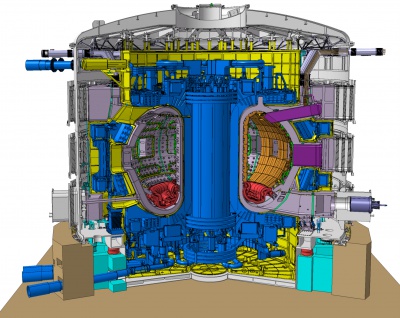ITER: Difference between revisions
Jump to navigation
Jump to search
| Line 47: | Line 47: | ||
|Burn time (s) || 400 | |Burn time (s) || 400 | ||
|} | |} | ||
In the standard scenario, part of the plasma current is inductively driven, so that operation is not steady state. Advanced scenarios seek to maximize pulse length by making use of the bootstrap current. | |||
== See also == | == See also == | ||
Revision as of 12:15, 25 August 2009

ITER is an international engineering and research project oriented towards demonstrating the technical and scientific viability of fusion as an energy source. For general background information on the project, refer to the Wikipedia.
Main specifications
ITER is a magnetic confinement device of the tokamak type. The reference operational scenario is the H-mode with the following characteristic parameters: [1] [2]
| Parameter | Value |
|---|---|
| Major radius, R0 (m) | 6.2 |
| Minor radius, a (m) | 2.0 |
| Toroidal field at R0, BT (T) | 5.3 |
| Plasma current, Ip (MA) | 15 |
| Edge safety factor, q95 | 3.0 |
| Confinement enhancement, HH98(y,2) | 1.0 |
| Normalised beta, βN | 1.8 |
| Average electron density, <ne> (1019m-3) | 10.1 |
| Fraction of Greenwald limit, <ne>/nGW | 0.85 |
| Average ion temperature, <Ti> (keV) | 8.0 |
| Average electron temperature, <Te> (keV) | 8.8 |
| Neutral beam power, PNB (MW) | 33 |
| RF power, PRF (MW) | 7 |
| Fusion power, Pfusion (MW) | 400 |
| Fusion gain, Q=Pfusion/(PNB+PRF) | 10 |
| Non inductive current fraction, INI/Ip (%) | 28 |
| Burn time (s) | 400 |
In the standard scenario, part of the plasma current is inductively driven, so that operation is not steady state. Advanced scenarios seek to maximize pulse length by making use of the bootstrap current.